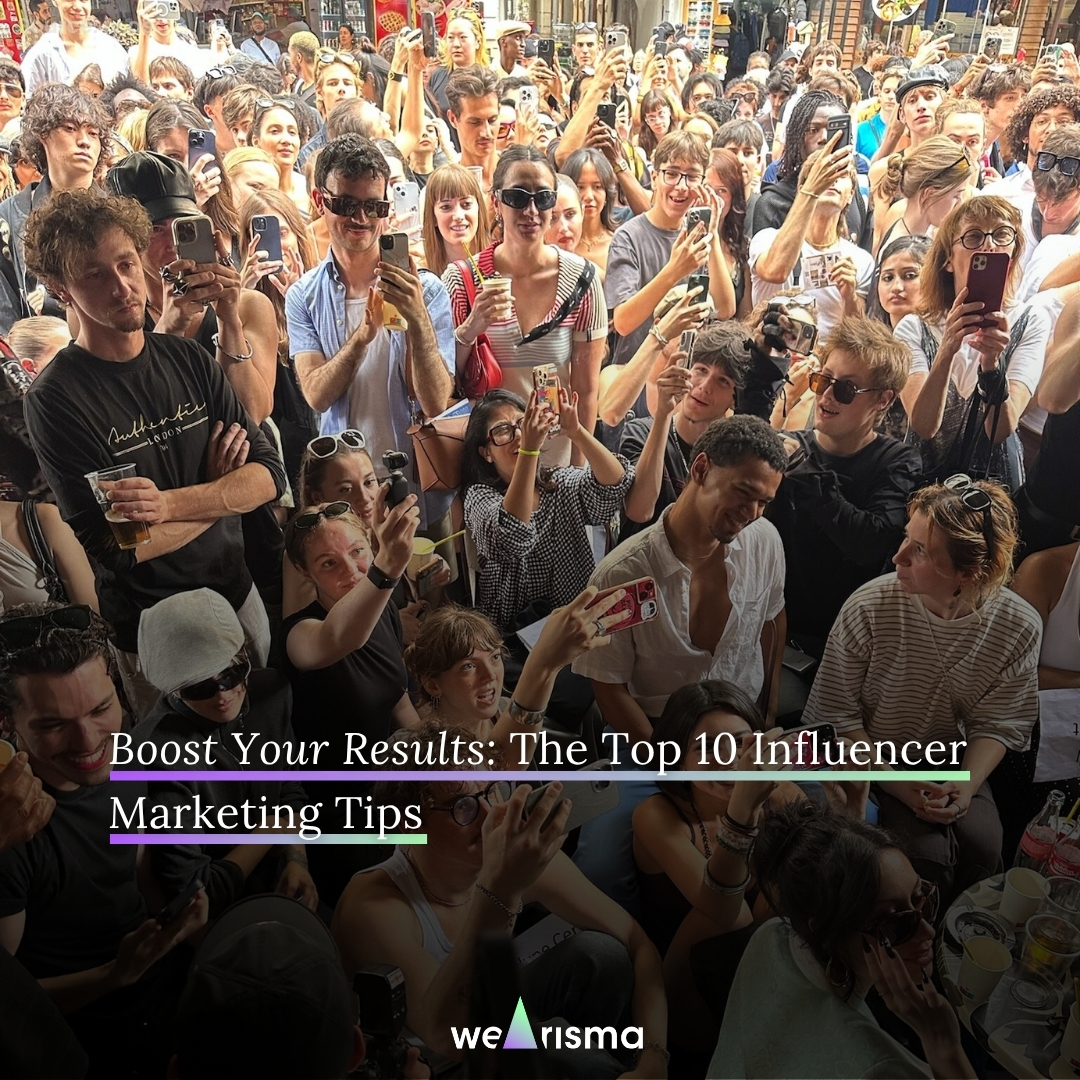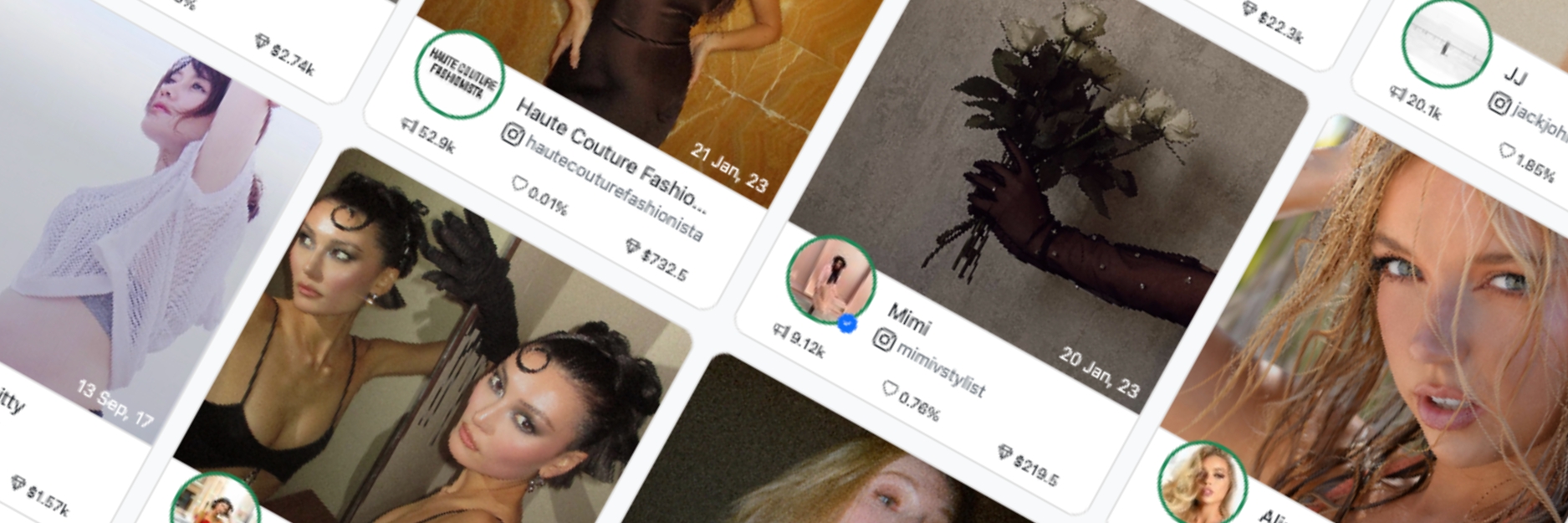🎉 WeArisma joins forces with NielsenIQ (NIQ) to, for the first time ever, measure the impact of Creator Marketing on sales.
The influencer marketing landscape continues its rapid evolution in 2025, with significant shifts in platform performance, creator tier effectiveness, and measurement sophistication. This report reviews the industry trends, performance benchmarks, and emerging opportunities shaping influencer marketing strategies.

Published On: April 16, 2025
Get ahead with a data-driven overview of 2025 influencer marketing trends, platform performance, and ROI benchmarks shaping strategy across industries.
We’ve entered a new chapter in influencer marketing. In 2025, and beyond, influencer and creator marketing strategies will be driven by authenticity, cultural relevance, and meaningful narratives.
From personal care to Sports & Athleisure and beyond, recent insights reveal that micro-influencers are driving higher engagement rates than larger creators across industries. We’ve also found that well-positioned cross-channel campaigns typically earn the highest return on investment (ROI). These trends are the tip of the influential iceberg.
For a deeper dive into these trends and a wealth of additional influencer marketing industry discoveries, read on.
The beauty industry continues to lead influencer marketing adoption, with micro-influencers proving most effective for product trial and purchase conversion. Ingredient-focused content consistently outperforms generic product showcases, while before and after transformations drive highest engagement but require careful authenticity management.
The industry shows clear performance differences between product categories. Skincare campaigns benefit significantly more from micro-influencer partnerships compared to color cosmetics, where visual appeal and aspirational content play larger roles. Clean beauty and K-beauty niches are frequently recorded as high-return segments, reflecting consumer interest in transparency and innovation.
Instagram remains the dominant platform for beauty content due to its visual-first approach, while TikTok shows strong growth for younger demographics and tutorial content. YouTube maintains its leadership position for detailed reviews and comprehensive product demonstrations.
FYI: For a deep dive into the latest trends shaping beauty, download our ‘2025 State of Influence Beauty’ interactive report.
Fashion brands face a unique challenge: significant brand exposure occurs through organic, untagged content where creators naturally wear or use products without formal partnerships (Wearisma internal detection data). This creates both measurement difficulties and authentic advocacy opportunities that traditional tracking methods often miss.
Current content trends show that street style and everyday wear content consistently outperforms studio-style shoots, while sustainable fashion messaging resonates strongly with Gen Z and Millennial audiences.
Size inclusivity and diverse representation have moved beyond trend status to become engagement drivers, and different fashion segments require completely different creator strategies. Fast fashion brands benefit from volume and trend-focused content, while luxury segments emphasize quality, craftsmanship, and aspirational lifestyle elements.
FYI: To uncover the trends shaping fashion right now, download our ‘2025 State of Influence Fashion’ interactive report.
B2B technology brands are discovering influencer marketing effectiveness, particularly through LinkedIn thought leaders and industry experts.
LinkedIn demonstrates the highest engagement rates for professional content, while YouTube continues to dominate for product demonstrations and detailed tutorials. Twitter/X maintains its relevance for tech industry discourse and real-time conversations, while TikTok is emerging as a viable platform for consumer tech marketing among younger demographics.
The B2B space presents unique opportunities as decision-makers increasingly seek peer recommendations and expert validation through social channels.
Post-pandemic travel marketing emphasizes a rising shift towards authentic experiences over aspirational luxury, with micro-influencers proving effective for driving booking intent.
The industry has shifted toward sustainable travel content, which generates higher engagement than traditional luxury positioning. Local experience focus consistently outperforms destination-only content, while budget-conscious travel messaging resonates with the current economic climate.
Domestic travel content maintains particularly strong performance as consumers prioritize accessible, authentic experiences over distant aspirational destinations.
Instagram continues to offer mature shopping integration and creator monetization tools, making it particularly effective for brands with strong visual components.
The platform’s diverse content formats—including Reels, Stories, Posts, and IGTV—provide multiple touchpoints for audience engagement. Robust analytics and measurement tools give marketers clear visibility into campaign performance, while the platform’s algorithm increasingly emphasizes engagement quality over quantity.
Recent algorithm changes favor original content over reposts, and enhanced creator bonus programs are improving creator economics. Instagram remains the go-to platform for beauty, fashion, lifestyle, and food brands that can leverage strong visual storytelling.
TikTok offers unmatched viral potential and organic reach, particularly valuable for brands targeting Gen Z and Millennial audiences. The platform rewards creative, authentic content and typically delivers lower cost per engagement than competitors. Yet regulatory uncertainty in key markets and limited advanced analytics compared to more mature platforms present ongoing challenges.
Creative content demands are higher on TikTok, requiring brands to adapt their production approaches and embrace platform-native formats. Even with these challenges, TikTok remains essential for brands seeking to reach younger demographics with entertaining, creative content strategies.
YouTube consistently delivers the highest revenue per creator partnership while offering robust search functionality that drives long-term content value. The platform provides detailed analytics and attribution capabilities superior to most competitors, along with multiple monetization options that benefit both creators and brands.
As one of the world’s leading social platforms, YouTube excels for educational content, tutorials, product reviews, and any brand messaging requiring detailed explanations. The platform’s integration of YouTube Shorts with long-form content creates unique opportunities for comprehensive content strategies.
LinkedIn’s professional, decision-maker audiences offer unique value for B2B brands and business-focused consumer products. The platform demonstrates higher trust and credibility for business content while showing strong engagement rates for relevant professional topics. A rising number of B2B brands now use creators primarily for brand awareness, reflecting the platform’s growing influencer adoption.
As a less saturated environment compared to consumer platforms, LinkedIn offers emerging opportunities for brands willing to invest in professional content and thought leadership strategies.
As micro influencers become an increasingly prevalent component of creator marketing strategies across industries, we decided to examine the key insights defining the ‘size of influencer success’ in 2025.
Based on industry benchmarks and performance studies:
Nano-influencers (1K-10K followers):
Micro-influencers (10K-100K followers):
Macro-influencers (100K-1M followers):
Mega-influencers (1M+ followers):
For Maximum ROI: Focus 70% of your budget on micro-influencers (10K-100K) that share your brand values and blend with your style or aesthetic.
For Brand Awareness: Balance a well-positioned micro (60%) and macro (40%) influencer mix.
For Niche Targeting: Emphasize nano and micro-influencers in specific communities.
For Mass Market Reach: Partner with macro and mega-influencers strategically for effective campaign amplification.
One of the biggest measurement challenges facing brands is tracking organic, untagged content where creators mention or feature products without formal partnerships.
Traditional tracking methods miss significant brand exposure, yet organic mentions often indicate stronger audience affinity than paid partnerships.
To measure your total impact and uncover a universe of untagged content, visual content requires AI-powered detection capabilities to identify brand appearances, while uncontrolled messaging creates ongoing brand safety concerns.
FYI: Our AI Organic Measurement tool leverages AI visual and video recognition technology to uncover up to 90% of conversations linked to your creator marketing activities. Book a demo to see how you can leverage the power of AI to elevate your influencer marketing strategy.
Multi-touch attribution presents ongoing challenges as customers interact with multiple creators before purchasing, and cross-platform customer journeys complicate tracking efforts.
Long consideration periods in categories like automotive or luxury goods make immediate attribution difficult, while privacy changes continue to affect pixel-based tracking methods.
To tackle the challenge head-on, brands are increasingly developing first-party data integration strategies and incorporating customer surveys and feedback to supplement traditional tracking methods.
Effective influencer marketing measurement extends far beyond traditional vanity metrics like likes and follows. Essential metrics include cost per acquisition (CPA) and customer lifetime value (CLV) from influenced customers, which provide clearer pictures of actual business impact.
Brand awareness lift studies through surveys help quantify upper-funnel impact, while engagement quality through sentiment analysis reveals whether interactions represent genuine interest or passive consumption.
Share of voice analysis compared to competitors helps brands understand their relative market position and identify opportunities for growth within their category.

AI-powered creator matching is revolutionizing how brands identify potential partners, offering improved brand-creator alignment through comprehensive data analysis.
Predictive performance modeling allows marketers to estimate campaign success before launch, while automated contract and workflow management streamlines operational efficiency. Real-time campaign optimization recommendations help brands adjust strategies mid-flight for better results.
Advanced analytics capabilities are becoming standard across the industry. Cross-platform attribution is moving from nice-to-have to essential infrastructure, while sentiment analysis and engagement quality measurement provide deeper insights than traditional metrics. Predictive lifetime value modeling helps brands understand long-term customer relationships, and competitive benchmarking capabilities allow for strategic positioning against market rivals.
The content landscape is experiencing a long-form renaissance as both YouTube and TikTok prioritize longer-form content creation. Podcast integration with influencer partnerships creates new storytelling opportunities, while educational and tutorial content consistently shows strong performance across demographics. Livestream shopping integration represents a growing commerce opportunity that blends entertainment with immediate purchasing capability.
An authenticity premium has emerged across all platforms, with behind-the-scenes content frequently outperforming polished posts. Creator vulnerability and transparency drive higher engagement, while mental health and social consciousness messaging resonate with audiences seeking genuine connections. Diverse representation has evolved from differentiator to baseline expectation across most brand categories.
Commerce integration continues to accelerate across all major platforms, with native shopping experiences becoming standard features. Creator-specific storefronts and affiliate programs provide new monetization opportunities, while live shopping events enable real-time purchasing experiences. Subscription-based creator relationships offer alternatives to traditional one-off campaign models.
The regulatory environment continues evolving with increased disclosure requirements and stronger FTC enforcement. Platform-specific creator fund regulations add complexity to partnership structures, while international compliance requirements create challenges for global campaigns. Brand safety and content moderation standards continue rising across all major platforms.
Priority actions:
Focus on micro-influencers in your specific niche for maximum ROI.
Choose one primary platform and execute consistently rather than spreading yourself thin.
Develop authentic product seeding programs to generate organic advocacy.
Implement basic campaign tracking through UTM codes and promo codes.
Build long-term creator relationships rather than one-off campaigns.
Strategic focus:
Implement cross-platform attribution to understand complete customer journey.
Develop creator relationship programs with preferred partners that share your core values and support your brand’s mission.
Test emerging platforms like LinkedIn for B2B audiences.
Invest in content amplification beyond initial creator posts.
Use advanced analytics to optimize ongoing campaigns.
Advanced strategies:
Deploy AI-powered creator discovery and performance prediction.
Build proprietary creator communities and ambassador programs.
Integrate influencer data with CRM for lifetime value optimization.
Pioneer emerging platforms before competitors establish presence.
Develop comprehensive measurement frameworks including brand lift studies.
Budget size aside:
FYI: Keep your finger on the creator pulse with needle-shifting trend and insights from our ‘Luxury 2025 State of Influence Interactive Report.‘
What should you look for in influencer marketing technology? Here we explore the key platform attributes you should consider to elevate your strategy in 2025 and beyond.
Key attribution & analytics requirements:
Must-have features:
Critical functions:
The influencer marketing landscape in 2025 rewards precision over popularity, authenticity over reach, and attribution over assumptions. Successful brands will be those that:
Strategic foundations:
Execution excellence:
Future preparation:
Understanding industry benchmarks is just the first step to enhancing your strategy. To truly maximize your influencer marketing ROI, you need comprehensive analytics, cross-platform attribution, and AI-powered insights that reveal the complete picture of your creator partnerships.
Learn how WeArisma’s advanced analytics platform can transform your influencer marketing from guesswork to growth engine.
About This Report: This analysis incorporates industry research, platform data, and performance benchmarks from multiple sources including social media analytics platforms, industry surveys, and marketing effectiveness studies. Recommendations are based on aggregate industry performance data and current best practices.
Key Sources: Marketing Measurement & Attribution Benchmark 2024, Sprout Social Q1 2025 Pulse Survey, Influencer Marketing Hub reports, and platform-specific performance data.
About WeArisma: WeArisma is the leading earned media and influencer marketing intelligence platform, trusted by global brands and agencies. Our AI-powered platform combines influencer discovery, campaign management, and advanced analytics to drive measurable business results.
Access timely cultural trends, strategic creator guidance, and industry best practices.
Discover the most groundbreaking entertainment marketing insights from our eye-opening panel discussion at ‘The State of Influence 2025 and future-proof your brand for tomorrow’s creator economy.
Media Value drives visibility, but cultural heat drives desire.


Join our community and get cultural insights, creator strategy guides, and real-world best practices.